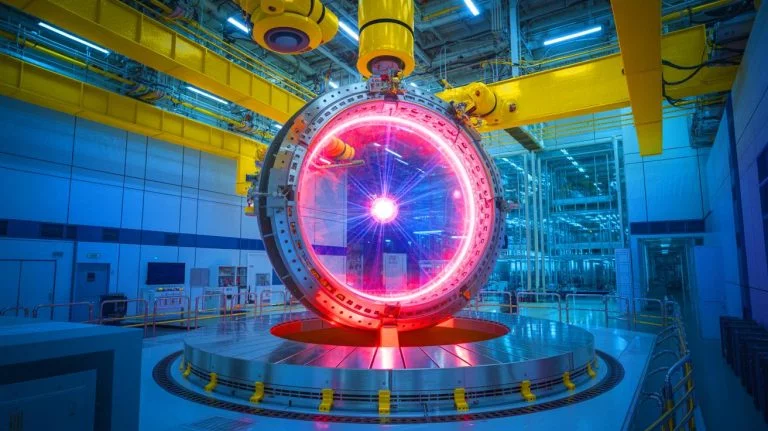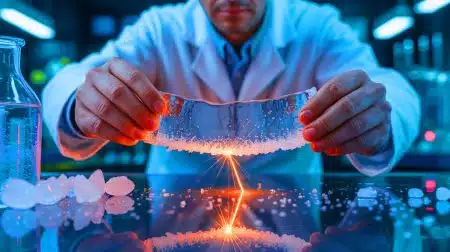| IN A NUTSHELL |
|
In a significant leap for nuclear fusion technology, the Wendelstein 7-X stellarator in Germany has set a new record in plasma duration, achieving a sustained reaction for 43 seconds. This development marks a milestone in the quest for clean and virtually limitless energy. Unlike traditional nuclear fission, fusion promises power without the toxic waste, relying instead on hydrogen ions. The breakthrough at Wendelstein 7-X highlights the potential of stellarators in advancing fusion research. As scientists continue to explore these technologies, the promise of sustainable and safe nuclear energy comes closer to reality.
The Promise of Nuclear Fusion
Nuclear fusion is the process that powers stars, including our own Sun. It involves the fusion of hydrogen nuclei into helium under intense conditions, releasing vast amounts of energy. The allure of fusion lies in its potential to provide an almost inexhaustible supply of clean energy. Unlike nuclear fission, which splits atomic nuclei and generates radioactive waste, fusion relies on abundant hydrogen ions and produces minimal waste.
For decades, scientists have been attempting to replicate this stellar process on Earth. While the concept is simple, the execution is complex. The conditions required for fusion—extremely high temperatures and pressures—pose significant technical challenges. Despite these obstacles, the potential benefits drive ongoing research and experimentation in the field.
Stellarators vs. Tokamaks
Fusion reactors are primarily of two types: tokamaks and stellarators. Tokamaks, with their donut-shaped design, have been the focus of most fusion research efforts. They use magnetic fields to confine plasma and have achieved significant milestones in plasma physics. However, stellarators offer a compelling alternative.
Stellarators are more complex in design but offer greater flexibility. They can maintain plasma with less power and have inherent design advantages that make plasma control more manageable. The Wendelstein 7-X, one of the most advanced stellarators, has recently demonstrated its potential by breaking records in plasma duration.
A Record-Breaking Achievement
The recent achievement at the Wendelstein 7-X stellarator is a testament to the progress in fusion research. By sustaining a plasma reaction for 43 seconds, the stellarator surpassed previous records held by tokamaks. This success was not only a demonstration of technological prowess but also a significant step toward practical fusion energy.
The experiment reached the “triple product” performance level, a key indicator of a reactor’s progress toward self-sustaining energy production. The triple product considers the density of ionized particles, ion temperature, and energy confinement time. Achieving this milestone in a stellarator highlights its potential to compete with, and perhaps even surpass, tokamaks in the race for fusion energy.
Innovations in Fusion Technology
The success of the Wendelstein 7-X was made possible through international collaboration and technological innovation. The fuel injector, developed by the U.S. Department of Energy’s Oak Ridge National Laboratory, played a crucial role. Additionally, contributions from European laboratories in developing advanced fuel pellets were vital.
During the experiment, the stellarator’s microwave heating system effectively reached temperatures of approximately 54 million degrees Fahrenheit. This was achieved using electron cyclotron resonance, a technique involving electromagnetic waves to heat and ionize plasma. The precise balance of heating and fuel injection was critical, showcasing the sophisticated engineering involved in this groundbreaking experiment.
The advancements at the Wendelstein 7-X stellarator represent a pivotal moment in the pursuit of nuclear fusion energy. By breaking records and setting new standards, this experiment underscores the potential of fusion as a sustainable energy source. The collaborative efforts of international scientists and engineers have brought us closer to realizing this dream. As research continues, one question remains: How soon can we harness the power of fusion for everyday use?
Did you like it? 4.4/5 (25)







Wow, 43 seconds! Is that long enough to make a practical difference? 🤔
Finally, some good news about fusion research. Keep it up, scientists! 🎉
Does this mean we’re closer to having fusion-powered cars? 🚗💨
Impressive achievement, but how many more years until we see this in everyday energy grids?
Are there any environmental concerns with this type of fusion technology?
That’s cool and all, but wake me up when fusion is actually powering my house. 😴
Why is sustaining plasma for 43 seconds such a big deal?
Thank you to all the scientists involved. Your work gives us hope for a cleaner future! 🌍✨
What’s the next milestone after achieving 43 seconds of plasma duration?
Is Wendelstein 7-X more effective than other fusion reactors like tokamaks?
Can this technology be scaled up for commercial use, or is it still too early?
43 seconds sounds short, but I know it’s a huge leap in fusion tech. Great job!
How much does it cost to run an experiment like this?
How soon can we expect fusion energy to impact our daily lives? ⏰
I love hearing about international collaboration. Together, we can achieve anything! 💪
Does the success of the stellarator mean tokamaks are outdated now?
How do they ensure the safety of such high-temperature experiments?
Is there a risk of radioactive waste with stellarators?
Why does it take so long to develop practical fusion energy?
Good stuff, but what are the potential downsides of using stellarators?
Are there any other countries making similar breakthroughs in fusion research?
Can this record be broken in the near future, or will it stand for a while?
What’s the main difference between stellarators and tokamaks?
How much energy was actually produced during this 43-second plasma? 🧐
I hope this leads to less dependence on fossil fuels. 🌱
Is the Wendelstein 7-X the most advanced stellarator in the world?
Fusion sounds promising, but what are the realistic timelines for implementation?
How do they keep the plasma contained for such a long duration?
This is a step forward, but how much longer until fusion is commercially viable?
Can fusion technology help combat climate change in the near term?
What are the implications of this breakthrough for future energy policies?
Very poor reporting. The record was for the triple product, not duration, and it actually happened in May.